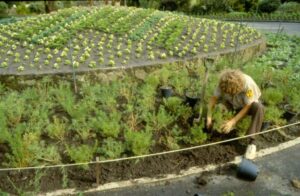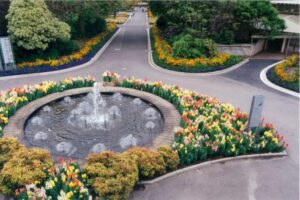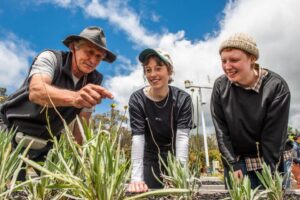
From cultivating cineraria’s to cultivating conservation
By John Arnott
At time of writing, I am a few weeks off ‘hanging up the boots’ at the Royal Botanic Gardens Victoria, entering a ‘retirement phase’ of a gardening career that has straddled five decades of public gardens horticulture. Over this period, I have witnessed numerous trends come and go, and thought it would be fun to quickly reflect on a few of these in this article.
I left high school in the late 1970’s and soon after was ‘indentured’ as an apprentice gardener at the ‘Royal Melbourne Zoological Gardens’ (Melbourne Zoo MZ). Horticulture and public gardening in the 1980’s was referred to as Amenity Horticulture and was strongly associated with the beautification of urban landscapes through ornamentation, and showy and colourful spring and autumn bedding displays.

At the time, the MZ was well known for extensive floral displays. Indeed, the MZ Main Drive was purported to have the largest single annual floral display in all of Australia… not sure that was ever fully substantiated, but it made for good press! I didn’t realise at the time that growing annuals on such a scale was providing this young gardener with a strong technical horticultural foundation. Successfully growing annuals involved a wide range of applied horticulture skills including soil management and plant nutrition, pest and disease management, weed management, plant propagation and production, irrigation and water management, and even garden bed design and layout.
I briefly left the zoo in 1984 for overseas travel. When I returned to Melbourne I was offered ‘my old job’ back at the zoo, only on this occasion the role was very different; that of horticulturist to the butterfly house project. The butterfly house signaled the start of another horticultural trend, the emergence of Zoological Horticulture as a stand-alone horticultural discipline. For the first time in the history of the MZ the success of an animal exhibit was completely contingent on horticulture for its success. An enormous behind-the-scenes effort was (and continues to be) required to cultivate the thousands of larval food plants to support the breeding life cycle of the adult butterflies to be released into the butterfly house. A huge, and at times complex horticultural problem-solving exercise.

Melbourne Zoo was about to undertake a transformation from environmentally barren cages and pit enclosures to naturalistic exhibits, with the resident animals displayed in immersive and heavily vegetated landscapes, drawing on habitat and enrichment principles. MZ was to be globally recognised as an exemplar in such displays, through exhibits such as the Gorilla Rainforest, Pigmy Hippo’s and Mandrills, the Sumatran Tiger, and Trail of the Elephants. This innovation has continued to today with Zoos Victoria, now recognised as one of the world’s premier zoo-based conservation organisations.
I left the MZ in 2000 and took on a role at the Geelong Botanic Gardens (GBG) as Curator/Director. The GBG was also about to undertake some major changes with the development of the 21st Century Garden, a new entrance landscape that effectively doubled the size of the gardens. The 21st Century Garden was designed by Chris Dance Landscapes at the end of the millennium drought. With this the garden strongly reflected on another major trend in urban horticulture in Australia, that of Environmental Horticulture. The Chris Dance design was centered in various expressions of low water use horticulture and sustainable horticultural principles. Plant selection for the 21st Century Garden was highly collaborative, leading to the establishment of living collections such as exotic xeriscape plants from Southern Africa, the Americas and semi-arid areas of Australia, alongside showcasing the indigenous plants of the City of Greater Geelong and surrounds. In some respects, these planting ideas were akin to current trends around Climate and Future Proofing in plantings.

The GBG is the fourth oldest botanic garden in Australia and the 21st Century Garden project was the catalyst for the renaissance of the garden, celebrating its place in our wonderful network of botanic gardens in Victoria and beyond. The six years I spent at the GBG opened my eyes to the world of botanic gardens and their very special place in community, horticulture, plant curation and display.
I was fortunate to hold some shorter-term roles at the City of Melbourne and at Wilson Botanic Park in Berwick, after which I secured ‘my dream job’ at the Royal Botanic Gardens Victoria (RBGV) Cranbourne Gardens.
For many years I had been tracking progress of the Australian Garden (AG) at Cranbourne and since joining the team at the RBGV in 2008 I have treasured the opportunity to contribute to its evolution and development. The AG was designed by the renowned Taylor Cullity and Lethlean, with plantings developed collaboratively with Australian Garden Plant Designer Paul Thompson and Cranbourne Gardens horticulture staff.
In 2016 The Cranbourne Gardens Masterplan set in place some new and challenging directions for the AG living collections. This led to several ‘shifts’ in key priorities for the development of certain collections, placing an increased emphasis on conserving the plant biodiversity of Victoria and south-eastern Australia through increasing the number of threatened Victorian flora in the living collection and the establishment of ex-situ conservation holdings. For the RBGV this signalled a strong focus on the emerging field of Conservation Horticulture.

In recent years the magnificent and dedicated horticulture staff at the RBGV Cranbourne Gardens have collected and established over 1400 wild-collected plants into the living collections. Further to this, the RBGV is at the forefront of an ambitious plant conservation outreach program, Raising Rarity, which heralds a further trend, that of Community Conservation programs. Raising Rarity aims to; engage home gardeners in meaningful species conservation through the distribution of a range of threatened plant species as garden plants; to work with school communities on conserving locally significant threatened species; to engage local government land managers in incorporating plant conservation into council managed lands; and through the Care for the Rare project, build capacity for regional botanic gardens to establish and manage conservation holdings.
It’s been quite the journey from growing annuals at the zoo to supporting community conservation programs and one I have cherished. It’s also one with many more chapters to come as I am planning to stay involved in all things plants and gardens – just not sure how I’ll fit it all in with the family, the grandkids, music and long leisurely bike rides!
